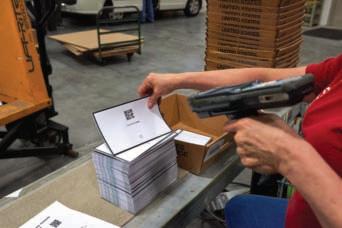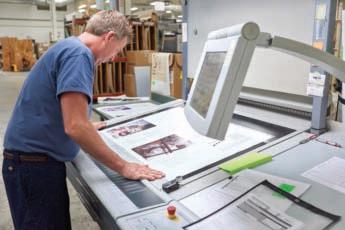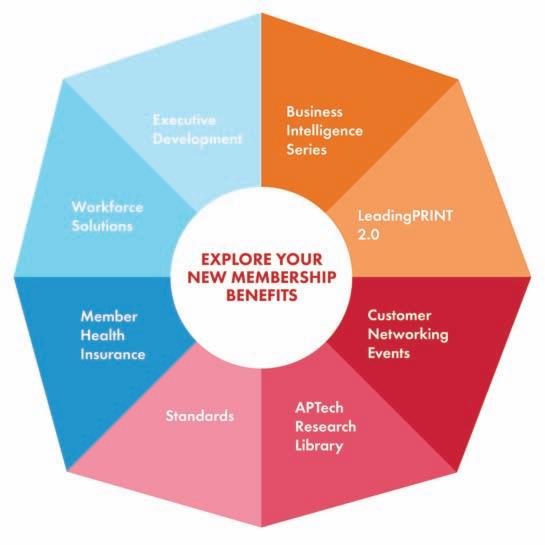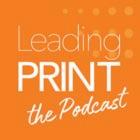Eyes Forward
Eyes Forward
How The Marek Group’s Tami Marek-Loper leads with purpose
The art of radically innovating Q&A with Sandy Alexander’s Mike Graff Computed photography & print Critical thinkers wanted

The art of radically innovating Q&A with Sandy Alexander’s Mike Graff Computed photography & print Critical thinkers wanted
Industry-leading technology and features Professional Services Team to train and advise Partnerships with media, workflow, and finishing providers 24/7 customer service
At Canon Solutions America, we don’t just sell new presses and walk away. We’re driven to help you reach inkjet success. How? By checking off all the boxes when it comes to ongoing support—from handling the daily realities of running a successful printing business to optimizing future opportunities for growth.

LEARN MORE ON HOW CANON





If you want to innovate like a superstar, you need to dare to become different
and do something unconventional.
Conventional thinking does not lead to new ideas, creativity or innovation. Yet most of us think conventionally. Even business creativity tends to be conventional. Our teams use the traditional brainstorming processes to generate a bunch of ideas that lead to pedestrian improvements in products and services. These conventional ideas are not much different than those generated in a similar company down the road.
If you want to stand out, if you want to be distinct from your competitors, if you want to innovate like a superstar, you need to dare to become different and do something unconventional. And maybe it starts with how you view your competitors overall.
Conventional thinking about the competition is not good. You probably think your competitors—the companies you have to watch out for—are a handful of printers similar to yours. Yet, those guys are not really competition because you already know what they are all about. You do the same conventional things to deliver the same service in the same exact way. Those printers are not your most dangerous competition.
The real danger exists with some group that you probably cannot even see right now. Some marketing-minded group that is in the ear of your client and has pitched them something unorthodox. And before you know it, you are left wondering what happened.
Listen, if you want to get excited and change the face of your business, you need to flush conventional wisdom down the drain and begin thinking unconventionally. You need to commit to being unconventionally unique in a marketplace full of nearly identical competitors.
Tami Marek-Loper understands unconventional thinking. As the Chief Visionary Officer at the The Marek Group, she leads with purpose. Read more about Tami and her ideas in our cover feature, "Eyes Forward."
And please enjoy the rest of this issue, which includes an insightful feature on how to maximize the inflection point of your business, and a story that highlights the need for critical thinkers in your business.
Unconventionally PRINT Technologies

2 4 8 12 14 18 22
REGISTRATION MARKS
Facts, figures and data that matters
How The Marek Group’s Tami Marek-Loper leads with purpose
How (and why) to radically innovate your company
New group tasked with bringing clarity to disruptive technology
INDUSTRY INSIGHTS
Economic outlooks and news
WANTED: CRITICAL THINKERS
Your staff requirements
Q&A
Mike Graff, President & CEO, Sandy Alexander
SPRING 2020
Publisher: APTech
LeadingPRINT magazine is published four times per year by the Association for PRINT Technologies. All rights reserved © 2020. Association for PRINT Technologies.
Managing Editor: Julie Shaffer
Creative and Editorial: Conduit, Inc. | conduit-inc.com
Find us online PRINTtechnologies.org twitter.com/APT_tech | facebook.com/APTtechorg linkedin.com/company/association-for-print-technologies For advertising opportunities, contact Sondra Benoudiz at sbenoudiz@aptech.org.
Send feedback and story ideas to jshaffer@aptech.org
Please recycle this magazine.
LeadingPRINT magazine is a benefit of belonging to the Association for PRINT Technologies. To learn how to become a member, contact Pernilla Jonsson at pjonsson@aptech.org

"People want to do well and do good. They want to understand how they’re making a difference in the world. Things change all the time, but your organization’s purpose transcends any individual product or service."



Study shows trends in employee engagement
Employee turnover is on the rise as employee engagement is falling, and businesses suffer. What are leaders to do? According to Qualtrics’ “2020 Global Employee Experience Trends” report, only 53% of employees around the world are engaged in their work. Here is what respondents say are the top drivers of employee engagement, in order of importance:


— Mark Weinberger, former CEO of EY Global, on operating with a purpose








Confidence in senior leadership to make the right decisions for the company
Opportunities for learning and development
A clear link between your work and the company’s strategic objectives
Recognition for good work
Managers who help employees with career development
53%





4 steps to give better feedback

Remember the last time you received feedback—formally or informally? How did you feel afterward? Motivated to change or frustrated? While employees report they want more feedback, they are often hurt by it, and their job performance suffers. The goal is to make employees feel empowered to achieve their goals rather than irritated. Here are four steps to give better, more effective feedback, compliments of the Forbes Human Resources Council:

The first step to providing good feedback is to know what you are dealing with. This can only be done by objectively observing.


Prepare yourself for your delivery. Make sure you are eliminating any bias and tailoring your feedback to each employee. Identify the behavior you want to see change and determine the most effective way to make that happen.


Some employees might not be thrilled to hear your feedback, so start the conversation by establishing trust. Let them know you are invested in their goals and want to help reach them. You are there to make them the best they can be, not just to point out what they are doing wrong. Showing them your feedback can help them achieve their goals, and they will be more apt to listen and take action.




More important than delivering your feedback is setting clear steps moving forward. This tells your employee you not only want to see them do better, but that you care enough to show them how. Be sure to recognize when they make changes.
By Tami Marek-Loper
In his book, "The Starbucks Experience: 5 Principles for Turning Ordinary into Extraordinary," Joseph A. Michelli, Ph.D., brilliantly laid out the essence of the brand’s success—a sociology-inspired concept known as “third place.” The concept refers to another place outside the home and work that people could gather and build a sense of community. Founder and CEO Howard Schultz’s vision was to create a chain where people are willing to pay a bit more for coffee because of the caché and potential connection that comes with the purchase.
The Starbucks’ story personally inspired me to push our team to create a “third place” concept within the print and marketing space. Similar to Schultz’ vision, The Marek Group strives to offer a resource our customers can turn to for their print, digital, promotional products, audio and visual and software needs. We no longer think of ourselves as a printing company; instead our vision is to “provide personalized sales material for all at scale.” This strategy enables us to seek opportunities in all areas without depreciating our vision.
Our promise is in our name. We are not Marek Printing, Marek Litho or Marek Marketing Services. We are The Marek Group. Once our vision was set, the branding came easily.
I do not think entrepreneurs think big enough and your vision is one of the most important parts of your business. And let’s not kid ourselves, vision is hard. It takes a lot of work to nail down who you are, what you do and where you want to go. Too many businesses simply cannot agree on a single vision or single purpose because they feel it narrows their opportunities.
Your journey starts with vision. It must come before the brand because without a clear vision, your brand will not have staying power. In other words, it is too hard to try and ride the ebbs and flows of a constantly changing business landscape without a clear picture of where you want to go. Trying to change with every opportunity is just not a recipe for success.
One of the things we pride ourselves on is practicing the EOS Traction business methodology, which is at the core of everything we do. The philosophy drives our branding, our culture, our goals and our decisions on a daily basis. The sixpart methodology includes: Vision — Get everyone in the organization 100% on the same page with where you are going and how you are going to get there.

into the organization and become great at executing your vision.
Every year, we hold an employee-only meeting to discuss our goals and initiatives for the coming year. The meetings, which are designed to be a positive reinforcement for our team, help roll out our corporate theme and marry our annual goals to our corporate vision. The meeting also includes social time, celebrations of our collective success, corporate branded gifts, and more.
This year our theme is “Together Toward Tomorrow,” which will help create a more unified team across the six companies that are part of
From where I sit, the arc of leadership has many different twists and turns, and should be treated as such. It is all about creating a beacon by which to steer your ship into the future.
The Marek Group. The goal is to bring more personalized products and services to our customers and prospects alike.
In addition, we conduct a series of programs throughout the year to help everyone stay aligned with the core values, vision and/ or annual corporate theme. For example, in departmental meetings, we start with a positive personal and business achievement from each attendee. We are even revamping our employee review process to incorporate our core values. A key component of the employee’s success is how he or she lived and breathed our core values on a daily basis. As an example, we encourage employees to give shout-outs to co-workers who go above and beyond the call of duty.
The best way for any team to maximize buyin from the top, down, is to let your team be part of the process. If your employees feel like they are part of creating the vision, they will be more apt to remembering and embracing it every day. Training each manager on your vision statement—the “why” behind it—will help lay the groundwork for the future of the business.
The first step is defining your brand’s perception to your employees and customers. This is likely the biggest differentiating factor for your business. Next, see if you can leverage the findings into a value proposition or
elevator pitch. Finally, meet with your most trusted employees and push them to help you make that value proposition relevant three, five and 10 years from now—longer even. If you can do this, you will lay the groundwork of what your vision statement should look like.
At The Marek Group, our mission is to be the industry leader in field sales effectiveness and marketing execution services—transforming the way our clients gather, manage, recommend, and distribute sales and marketing content to the field.
To continually reinforce this vision, our team of nearly 200 professionals in the field help execute and deliver on the strategies we employ for some of the country’s most recognized brands. Our company’s five tenets are as effective as they are straightforward:
1. Leadership: Have courage to shape a better future for our clients.
2. Collaboration: Leverage collective genius.
3. Integrity: Be real, honest and committed at all times.
4. Accountability: Take ownership and honor commitments.
5. Quality: Pride in quality, always striving for best in class.


Stay agile. Listen. Learn. Engage. Innovate. Do this, and every step of the way will be filled with reward.
On a personal and professional note, I am a big proponent of setting and achieving goals. Each day has a purpose for me, my family and my company. I have established myself as a visionary thinker who pushes the envelope of what is possible in order to achieve the best for my company and my clients. In an industry that continues to change, you have to keep thinking outside of the box. This is where you find the ideas and inspirations that can help change the world. This is what I push my team to do each and every day.
From where I sit, the arc of leadership has many different twists and turns, and should be treated as such. It is all about creating a beacon by which to steer your ship into the future—an endeavor none of us should take lightly. Having good vision enables you to
make better decisions, avoid those shiny and often distracting objects, and be happier. Giving yourself a purpose each and every day means you are committed to something worth achieving. This, I have found, will give you the inner peace to fight the daily fight.
As you set your sights on the road ahead, remember this: Your vision shows what your brand seeks to achieve in the short- and longterm. At the highest level, it sets the direction and purpose for you, your stakeholders (your team and customers) and your industry. Stay agile. Listen. Learn. Engage. Innovate. Do this, and every step of the way will be filled with reward.
It is a code that every entrepreneur should honor.

By Jennifer Morrell
How (and why) to radically innovate your company
“Pivoting should always be on the table as an option, because it has the potential to open new revenue streams for your business. You have to be fully invested in your pivot to maximize the moment.”
Joy Gendusa, Founder & CEO, PostcardMania
PostcardMania's latest pivot has been almost entirely technology based. You read that correctly—its latest pivot. Before you get to the dynamics of the latest retooling of the company that Joy Gendusa started in 1998 with just a computer and a phone, it is important to chronicle just how many times she has hit the reset button. And just how successful each one of those resets has been for the full service postcard direct mail marketing company.
The first time PostcardMania pivoted, it was a small design and print brokerage firm. Gendusa, recognizing the need to create a product she could scale, changed the business thinking from being all things to all people to specializing in direct mail postcards. The next pivot came as large commercial printers, recognizing PostcardMania’s success, started copying the concept and undercutting its prices. With the ball in Gendusa’s court, she repositioned the company from being a printer to a marketing company that specialized in lead generation—using direct mail postcards as the first channel.
The company’s third iteration happened with the incorporation of digital channels attached to direct mail with integrated tracking methods— DirectMail2.0, as Gendusa calls it. PostcardMania spun the concept into a product it called Everywhere Small Business. In order to help small businesses get leads, PostcardMania had to utilize Google and Facebook, coupled with mail tracking and call tracking, to get the best results. That was in 2013.
“As a company, you have to be responsive to what the market is doing, because that affects what your customers want, need and expect
from you,” Gendusa says. “Pivoting is important because it opens your business up to a new type of customer in a saturated market, and continues to differentiate your brand from the competition.”
Is the strategy mandatory? Gendusa says absolutely not. “Every business and every business owner is different. For those that are always looking to grow and expand though, pivoting is probably in the cards.”
Back to where we started, PostcardMania's latest pivot has been almost entirely technology based. Gendusa had tried several times to create an online storefront, where business owners, marketers, etc., could order direct mail marketing pieces online themselves. But it was important to Gendusa that PostcardMania not sacrifice its marketing expertise for online ordering convenience.
“We're a marketing company that specializes in small business advertising first, and a printer second,” she says.
In 2018, after PostcardMania started operating at a level of profitability under the watchful eye of her senior executives, Gendusa set out personally to make the pivot happen, hiring a staffer to work directly under her to research the industry and create new contacts to gauge demand.
“Once we fully understood the new industry we wanted to pivot into, and had thoroughly researched the competition and how to be better than them, I focused on hiring developers,” Gendusa says. “Once you have the vision and the right people in place, it's just a matter of trial and error and putting yourself in the shoes of the end user until you get the technology right.”
“Having a mindset of exploration, of risk, and of future vision is critical. The last thing anyone wants to do is build the proverbial plane as they fly it.”
— Randal Moss, author, 'IGNITE: Setting your Organization's Culture on Fire with Innovation'
Today, PostcardMania reflects the technology company she had always envisioned—one that offers proven, results-based marketing and superior printing quality on demand. “Pivoting should always be on the table as an option, because it has the potential to open new revenue streams for your business,” she says. Sure, the investment is higher, but so are the potential returns. You have to be fully invested in your pivot to maximize the moment—do it right and see it through to the end. It's essentially like starting a new business from the ground up, and all of those initial costs and investments have to be done to get everything up and running smoothly and profitably.”
In their book, "IGNITE: Setting your Organization's Culture on Fire with Innovation," David Neff and Randal Moss present a scalable process that companies can implement to find, evaluate, develop and launch their next major innovation. Big proponents of testing and learning, Neff and Moss say that in today’s ultra-competitive business landscape, the blueprint for finding your place is to identify your objective and goals, find the problems getting in the way, and then design hypotheses to test where and when pivoting is necessary.
“Pivot is not always the answer,” Neff says. “The answer would be rooted in approaching that moment with a test and learn an experimentation mindset. What was the problem? What was our hypothesis? How did we run a test? What were the results? Only then could you take the data and pivot.”
As the authors stressed in their book, they firmly believe that all new ideas, innovations and pivots can be approached with a stage-gate mindset as a series of experiments. While this was once confined to innovation departments and R&D labs, this behavior—and the sometimes obsession with it—rests in testing how the model works.
Moss says that pivoting is more like a slow turn— think a cruise ship as opposed to a ski boat. Large organizations rely on strategy as a rule of thumb and get beholden to it. To make a change is to shift the whole institution, a move he says takes energy and time, which are often in short supply during a pivot-or-die situation. On average, smaller organizations are better positioned to pivot. Smart, larger organizations can structure themselves so that sub-sections can reinvent themselves independently.
“Being organizationally prepared is mission critical,” Moss says. “Having a mindset of exploration, of risk, and of future vision is critical. It is far easier to take advantages of 'a moment' when there is structure in place to do so with resources on standby and a process for fast validation and testing. The last thing anyone wants to do is build the proverbial plane as they fly it. You know opportunities will present themselves, so get ready in advance. It does not matter what they look like so long as you are prepared to take advantage of the moment.”


With pieces like this, PostcardMania is a marketing company that specializes in small business advertising first, and a printer second.

Taking advantage of the moment is something that Gendusa and PostcardMania know well. While she says pivoting is still pretty rare in business today with more than enough to keep a company busy, when the opportunity presents itself, act.
“You have to be somewhat separate from the dayto-day minutia before you develop enough of a viewpoint to see your business and your industry from the outside, and see where it's headed,”

Gendusa says. “You can't develop that viewpoint without having the right people in place to take care of your business and ensure it continues to grow and expand without your hand directly guiding every move. For me, it happened many times for different reasons.”
As PostcardMania settles in on its latest business strategy, Gendusa and her team keep an eye on where the market may take them—pivot in tow.
A solid leadership team to keep your core business running smoothly and profitably
A vision for where your industry and business is headed in order to pivot that way (plus a proven ROI to back it up)
Enough reserves to cover your new investment costs
The drive and time to dedicate to carving out a new uncharted path for your business

By Don Carli

If you want to see how e-commerce and 3D computer graphics are disrupting the retail market, look no further than home furnishings. Research from Statista estimates that U.S. retail e-commerce revenue for the market segment will grow to more than $100 billion by 2022, up from $65.1 billion in 2018.
The growing importance of e-commerce is also increasing the use of photorealistic 3D imagery, which was first pioneered by IKEA in 2005. 3D imagery also is creating the need for standards to manage the color and appearance of 3D content. In addition, home furnishing retail brands are likely to value high-impact digital print applications employing the new iccMAX (ISO 20677)
standard for color and appearance management, which can leverage new open standards under development for 3D content.
Today, nearly every major furniture brand has 3D initiatives underway. Both online and brick and mortar retailers are experimenting with 3D computer graphics, physically based renderings, and augmented reality (AR) technologies to reduce the time and expense associated with creating content, re-using content and delivering more immersive e-commerce customer experiences.
Neil Trevett, president of the Khronos Group, says 3D content is poised to become pervasive in retail. The Khronos Group is a member-funded non-profit
industry consortium of more than 160 leading hardware and software companies that has been developing open, royalty-free standards for 3D graphics, AR and virtual reality (VR), vision and machine learning for 20 years.
But despite the trend toward the ubiquity of 3D content, there is a lack of cross-platform standards for displaying virtual product models. This is preventing the color and appearance of 3D content from being experienced consistently.
Shrenik Sadalgi, director of the Next R&D Group at Wayfair, is chairing the newly formed 3D Commerce Working Group, a collaboration of more than 160 leading retail and technology
“It is a new experience for us to have assembled such a diverse group. It's a bit like herding cats at this point, but it's a herd of very smart, cooperative cats." Neil Trevett, President, Khronos Group
“Bringing this kind of radical change across the retail industry will require collaboration between many different retail and technology companies.”

— Shrenik Sadalgi, Director of Next R&D Group, Wayfair




brands, including IKEA. The group is tasked with exploring the opportunity to accelerate the adoption of 3D experiences by establishing a set of universal standards for platform-agnostic 3D model creation and distribution.
The new 3D Commerce Working Group is breaking new ground in a number of ways. "Before this, Khronos working groups were primarily composed of tech companies,” Trevett says. “Either the platform vendors like Google, the GPU vendors like Nvidia, or the tools vendors like Dassault or Autodesk. But now we actually have 'end-user' brands joining us, and that's a first for Khronos.”
Trevett hopes this will be the first of many, particularly because it makes the group more effective in identifying and solving industry problems. “It is a new experience for us to have assembled such a diverse group. It's a bit like herding cats at this point, but it's a herd of very smart, cooperative cats."



for retailers and technologists alike. “Bringing this kind of radical change across the retail industry will require collaboration between many different retail and technology companies.”
That is why the Khronos Group is making it a priority to establish the first equivalent of the JPEG for 3D. Enter the 3D Commerce Working Group, which is expected to incorporate previous Khronos standards such as OpenXR, WebGL, glTF and Vulkan (see sidebar, “3D Commerce Synergy with Other Khronos Standards").
In addition, Trevett sees the group incorporating advanced open standards for color and appearance management like iccMAX (ISO 20677), which support the consistent representation of expanded-gamut color and appearance in digital media as well as 2D, 2.5D and 3D print media.
The 3D Commerce Working Group, a newly formed arm of the Khronos Group, is leveraging and helping guide the evolution of other Khronos open standards, including:
• glTF for transmission of photorealistic 3D assets
• WebGL for interactive 3D applications on the Web
• Vulkan for highperformance, interactive 3D graphics for applications such as Augmented Reality (AR) and Virtual Reality (VR)

Sadalgi believes the industry needs standards and guidelines so that 3D content can be experienced consistently across a variety of platforms and on a variety of devices. Other challenges that standardization can help address include optimizing industry workflows to minimize cost, and bringing down barriers to entry

As more brands begin to create imagery with CGI and 3D graphics, standards like iccMAX (ISO 20677) and the work of the ICC to create color visual appearance specifications that go beyond current color management practices will become mission-critical. In addition, groups like Association for PRINT Technologies (APTech) are leading the effort to raise awareness around iccMAX and other open standards.
• OpenXR for enabling AR and VR applications that are portable across multiple vendor platforms

• OpenVX for portable, power-efficient vision processing and inferencing used in AR and scanning applications

— Ryan Babenzien, founder & CEO of GREATS, on digital marketing’s limitations


When it comes to economy talk, the conversation always comes with a sense of anticipation. But ask today's marketers and they will tell you they are optimistic about the future of consumer spending. According to the “Marketers' Confidence Index January 2020” survey by the American Marketing Association and Kantar Consulting, the outlook over the past six months has increased, from 37% in July 2019 to 47% in January of this year.
Yes, it is a digitally driven world. But those of us in the print services industry don't count out direct mail just yet. We know that print mail cannot be easily deleted like email. Here are five tips from Marketing MO that can help you or your clients create better direct mail campaigns:

Use a clean list One of the most important parts of your direct mail campaign is your list. Outdated information and incorrect addresses are money down the drain.







Project conversion metrics — Calculate your cost per unit and project a conversion rate. This will help you determine the ROI of your campaign prior to running it.

Make the offer clear — The recipients should know exactly what action you are asking them to take within a few seconds, because that often is all the time your piece will get.




Plan fulfillment — Plan how to handle positive responses—and make sure to track them.






























































Measure results — After it is all said and done, you must figure out your ROI. If it did not do so well, it is an indicator you need to do something different next time. 61% Immediate need for an item 59% Lower delivery price






Delivery matters. People want things and they want them now, especially the younger crowd. According to OIG's "Same-Day Delivery Survey," while there is a growing appeal of same-day delivery (thanks urban millennials), the method still only accounts for 2% of all parcels. Here is what could prompt consumers to choose same-day delivery more often:
Able to choose delivery time 48% Joined subscription service with lower delivery price 40% Flexible "where you are" delivery



Executive development. Industry standards. Student design. In its continuing effort to enhance the stature of the print landscape, the Association for PRINT Technologies (APTech) is playing a key role in helping to advance the industry's leadership acumen.
The first program involves a bold new collaboration in executive development with George Mason University's Graduate School. Together, APTech and George Mason will design a program to provide print industry leaders with the knowledge, skills and abilities required to successfully transform their companies and generate continued success.
This graduate-level curriculum has developed strategic frameworks for leaders to reinvent their organizations and develop new or revised business models based on an innovative vision for the future. The program consists of three sessions of activity that are essential for leading organizational transformation, including Marketplace Disruption (Vision of the Market), Customer Principles (Vision of the Customer) and Implementation (Vision of the Process).
The program, taught by GMU Graduate School of Business professors, will be delivered through GMU’s Learning Management System over a nine-week period. Participants successfully completing the program will earn George Mason University School of Business certificates of completion.
1
For those on the supply chain of the industry, having a critical understanding of production and safety standards is imperative to the process. That is why APTech, the only ANSI-accredited association providing leadership in standards development for the printing industry, remains committed to the cause. For more information, check out “The Blue Book” — A Reference Guide for National and International Standards Activities," which provides a detailed account of what every supplier needs to know.
APTech also offers its APTech Standards programs. The group administers two committees that develop national standards (B65 and CGATS); the U.S. Technical Advisory Group to TC130 (USTAG), and five working groups and task forces in ISO/TC130. APTech also acts as the Secretariat to the International Color Consortium (ICC). The goal is to provide information for the entire printing industry on standards development. Through the Brand Owner Council, APTech provides a forum for brand owners to meet and discuss their needs. As a result, the council developed a roadmap for the packaging industry that aligns the entire supply chain.
Membership in any of its standards programs is open to anyone with an interest.

Presented by APTech in partnership with Konica Minolta, the "2020 Student Design Competition" encourages students to demonstrate design-to-print knowledge and create an original printed entry. The competition also helps expand awareness and interest in the print industry and exposes the future workforce to print beyond theory.
This year's theme—MAIL MATTERS!—focuses on the tactile component of omnichannel marketing and the importance of personalization. The competition is open to all students who attend recognized secondary or post-secondary institutions in the continental United States and and are studying in a graphic communications, printing, advertising, graphic design and/or interactive media program.
Deadline entries must be submitted and postmarked by June 5. Students can enter online at https://PRINTtechnologies.org/SDC.












From Super Smooth, Smooth nishes the true white and From Super Smooth, Smooth and Vellum finishes to the true white and so cream shades, Lynx® is the brand of paper with digital, offset and inkjet options built to deliver dramatic results.
PAPER.DOMTAR.COM




By Alyssa Ruane

worried about what is happening internally—what orders are coming in, what shipments are going out. And while you are in your company's bubble, other industries are edging their way into yours.
By Jennifer Morrell
And there is the outside bubble. It can feel scary looking outward today, especially with issues like the COVID-19 forcing your customers to reexamine the way they do business. But you must persevere—you must do what you must in order to stay afloat and ahead. Kate Zabriskie, founder of Marylandbased consultancy Business Training Works Inc., has been in the corporate training business for 20 years. While observing trends and listening to companies’ key needs, she says the one thing that has been consistent is change.




And today’s hiring landscape needs to reflect that change. What change, you ask? Well, the way we do our jobs, to start.
Enter the robots.
“A lot of the administrative stuff is moving to selfserve,” Zabriskie explains, noting how that shift is also eliminating the person-to-person sales relationship. She asks, “When was the last time you went to the bank?”
“Last month—to buy a house,” I reply. “For everything else, I use the app.”
“Exactly,” she says.
"A critical thinker will inquire beyond the initial question, asking why and getting a deeper understanding of the problem."
— Kate Zabriskie, Founder, Business Training Works

“A smart thing to do for any business is to look around at other industries,” Zabriskie says, and wonder, how is this going to affect me?
The internet was a large external influence that disrupted many industries. Not just banking, not just printing.
To stay ahead of your competitors when the next big shift happens (hint: it is already happening), human resources consultants say companies must seek and employ critical thinkers. Dictionary.com defines critical thinking to be, “disciplined thinking that is clear, rational, openminded, and informed by evidence.” (The irony of citing an online dictionary in lieu of a physical one should not be lost on you.)
Wondering about external influences as Zabriskie mentions is one facet of critical thinking. And while it helps for leaders to have these skills, it is just as helpful—and necessary—to have critical thinkers throughout the company.

In order to survive, Jeremy Eskenazi says employing the skill of critical thinking is vital, especially in industries like printing that are big on pricing. The ability to differentiate is really important, and how they do it is through the people.

“In the workplace, you can achieve a lot more with people who use critical thinking to solve problems,” says Eskenazi, managing principal of Riviera Advisors, a talent acquisition management consulting firm based in Long Beach, California.
By investing more in this type of talent up front, it can benefit your bank account in the long-term. When employees are thinking for themselves and formulating their own solutions (even if those solutions are not utilized each time), the need for managers and supervisors is greatly minimized— maximizing your bottom line.
Does the job require critical thinking? Eskenazi says to figure that out before you begin the hiring process.
Of course, not all jobs require critical thinking skills.
Line workers and accounting departments may not need to possess creative problem-solving skills as much as those who are interfacing with clients on a daily basis or working in business development.
To understand if the job needs a critical thinker in place, look at it from a performance standpoint.
While it is important to have specific knowledge requirements for particular jobs (i.e., doctors need to have medical degrees), do not get too caught up on “wish list” items or industryspecific systems. Instead of looking at what traits you want this person to have, outline the key accountabilities you want them to achieve. Then, you will be able to assess how much critical thinking power this person should possess. It is not an either-or.
Eskenazi says critical thinkers are most critical “anytime there are decisions to be made that have impactful outcomes.” Now more than ever, printers are making decisions that have impactful outcomes.
“In the workplace, you can achieve a lot more with people who use critical thinking to solve problems.”
— Jeremy Eskenazi, Managing Principal, Riviera Advisors
There is no doubting the internet’s impact on the printing industry, and the experts the way to compete with “The Amazon Effect” (the consumer expectation of receiving everything immediately) is to employ critical thinkers that can bring you out of the box and out of the industry bubble.
Eskenazi makes a sharp observation that many printers do not hire from outside the industry. While it can be uncomfortable trying something new, both HR experts say hiring critical thinkers from outside your industry is the way to nurture new ideas, which can then lead to new avenues of success.
With an attitude that does not welcome ideas from all employees, though, it is tough to cultivate a forward-thinking business full of self-starters. Zabriskie offers company culture consulting to clients as well and says it is imperative for the culture to support open-mindedness in order to benefit from critical thinkers.
Letting go of traditions can be tough, but it is even tougher letting go of a company. To truly compete with today’s heightened consumer expectations and broadened playing field, fresh ideas—and a culture that fosters them—will elevate a new era of traditional printers that made it into the modern age.



Because critical thinking requires a person to be inquisitive, one of the best ways to find critical thinkers during the hiring process is to ask— and receive—the right questions.
Zabriskie says if she asks someone a question, she does not want a simple “yes” or “no” answer. "A critical thinker will inquire beyond the initial question, asking why and getting a deeper understanding of the problem. Asking why, why, why. A big piece of this is making sure I’m actually solving the right problem. If we identify the correct issue, we’re so much farther ahead.”
Think about the time (and money) wasted when someone makes a poor, snap decision without weighing all the options. Critical thinkers naturally think things through a bit more.
As the interviewer, both experts say it is also important to set and manage expectations. Tell interviewees ahead of time that you will be asking questions that pertain to X, Y, Z, that require thinking, and that silence is okay. After too many long, uncomfortable, silent moments, though, Eskenazi says, it is a red flag.
He also says to make sure you get the personal experience, not the shared experience, when asking about projects in past roles. If the candidate says, “We did X,” stop them and ask, “What did you specifically do to solve this problem?” The context is important when you are looking for a self-directed problem-solver.
You can train current employees to be independent thinkers, too. “I’m not sure that this is an innate skill,” Zabriskie says. “It can absolutely be taught. But don’t expect people to be good critical thinkers if you don't show them what that looks like.”
1 2 3 4 5



Set & manage expectations
Define key accountabilities in the role
Ask questions that show problem-solving skills
Look for deeper questioning
Foster an open-minded work environment


Graff, President & CEO, Sandy Alexander
Mike Graff is not shy about speaking his mind. With 30-plus years under his belt, the president and CEO of Sandy Alexander has earned that right, and has mastered the art of venturing through both good and not so good times. Through the years, his leadership record includes successfully charting restructuring courses, strategic acquisitions and overseeing portfolio mixes involving myriad digital technology/output devices. His industry stewardship led him to being named to Printing Impressions/Rochester Institute of Technology (RIT) Hall of Fame in 2012. In his spare time, Graff even found time to be a volunteer fireman for more than 25 years in New York City, where he also served as the chief. We sat down with Graff to get his take on the industry and where it is heading.
How do you do that?
It does not happen by going to a trade show and buying a new piece of technology. You cannot buy a piece of equipment and go out and sell it. There could not be a worse recipe for success. First, you must have a solid reputation because you are going to be asking for some goodwill. If you are a shaky company—and I do not just mean financially—getting new technology is not going to help you.
Second, you must find out what clients are doing. While many companies say they listen to their clients, there are countless that do not truly understand them. If you do not understand your clients on a intimate level, they will guide you off a cliff. They will have you investing in all sorts of fancy stuff they may never utilize. So again, it is two sides of an equation here. It is not binary.
How do you get the right people on the bus all moving in the right direction?
It is a cultural change. When I give people a tour of my facility, they see print. But they also see a welding shop, a wood shop and a paint booth you could drive a bus into. We are building things that are exciting and complex, but they are what the clients need. This is all presented internally as opportunity, as opposed to a threat.
So the offering has changed, but how has getting to the customer changed?
It is tougher and tougher to canvass and cold call. This is my 40th year. I remember when I could walk into a building, take an elevator up and
Give us a snapshot of the industry today. As time has passed, we have collectively gone from a narrow scope of work—when there was a plethora of it—to a more complex landscape. Specifically, there is a mirror-like dynamic between the supplier and client sides. The clients now have a smaller pool of talent that is trying to execute on a more complex marketing spend. And we have a smaller pool of printers, but because there are more channels, there is less concentration within that narrow band. So for those who want to persevere, they must widen their band.
down, and search for a business that was target rich. You cannot do that anymore. The barriers are too high. So you do it through education and reputation. You must commit to a value proposition and then there is something in it for your customers, whether it is factual or perceived. If we are not intimately engaged with our clients and provide them something that is actionable and usable for them, they do not need us.
Where did this mindset
My career has always been on the sales side, so it is important to me that our company knows the day-to-day struggles of our clients intimately.

Having visibility in the market and into the mind of the buyer is essential. I feel very strongly that leaders in a company should have sales experience. I hire that way, too. Even people that I hire for technical roles should have some sort of customer-facing experience.
What keeps you up at night?
Getting the right people. The next generation does not see this as a glamorous business. They think it is a smokestack category, but
has a brand problem and it leaves me challenged to replace the people who are aging out of the business.
What is your advice as we move into a new decade?
We hit two recessions in a technological revolution, so everyone's been focused on survival. Nobody was able to invest in a new strategy and personnel. But prosperity is rooted in a need for intimacy with the marketplace. My whole job is based on what is next.
You must commit to a value proposition and then adopt the mantra that there is something in it for your customers, whether it is factual or perceived.



If you are looking for insights from some of the industry's most prominent leaders and innovators, we have a podcast for you. The LeadingPRINT Podcasts—our own little "fireside chats" feature short, entertaining conversations hosted by Thayer Long, President of the Association for PRINT Technologies (APTech).
Along with catching up on the industry’s latest news, updates and trends, you can hear our guests dish on what it takes to thrive in today's ever-changing, always exciting business landscape. Get the inside track on how to grow your business from the experts who know the ropes.
The LeadingPRINT Podcast is available on Spotify and iTunes.




































































